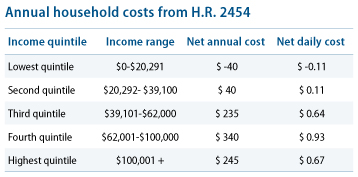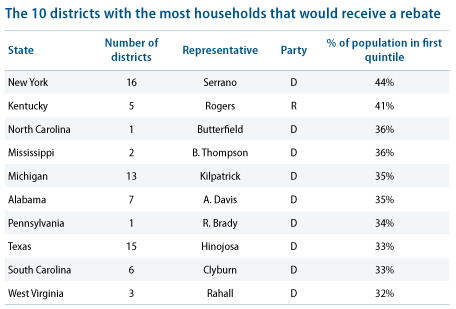This piece was co-written with Andrew Jakabovics, Associate Director for Housing and Economics at the Center for American Progress.
Opponents of the American Clean Energy and Security Act, H.R. 2454, are acting like out-of-control auctioneers. They’re trying to defeat the bill by raising cost estimates for the bill’s clean-energy and global warming pollution reduction programs. But their wild estimates have been based on either perversions or distortions of independent government and university studies, or are partisan studies with rigged assumptions designed to produce outlandish estimates.
The Congressional Budget Office announced on Friday that the average American household would spend only a very modest amount each year to reduce global warming pollution under H.R. 2454. This independent analysis determined “that the net annual economywide cost of the cap-and-trade program in 2020 would be $22 billion—or about $175 per household.” This is $3.36 per week—about the cost of one pound of 93 percent lean ground beef.
And the poorest 20 percent of households—those with incomes under $20,292 in 2007— “would see an average net benefit of about $40 in 2020,” according to the CBO.

Many conservatives not normally known for concern about low-income people are questioning how the bill will affect the poor, trying to use that as a reason to oppose passage of H.R. 2454. But CBO and Census data indicate that districts with significant numbers of low-income households would face relatively small costs under this bill in 2020. There are 64 congressional districts where at least half of all households would pay an average of 11 cents per day—or less than one-fifth the price of a 12-ounce can of soda (see attached chart).
There are another 85 districts where 40 to 50 percent of the households would incur average costs of 11 cents daily. And 30 percent or more households in an additional 21 districts would actually receive an average net benefit of $40, according to CBO.

CBO’s cost estimates are actually quite conservative (low) since the calculation “does not include the economic benefits and other benefits of the reduction in GHG emissions and the associated slowing of climate change.”
CBO’s estimate also does not include the economic benefits of other provisions in H.R. 2454. The American Council for an Energy Efficient Economy estimates that the efficiency provisions alone could save consumers $22 billion annually by 2020. The savings would be $170 per household—nearly equal to CBO’s average annual cost per household to comply with the bill’s greenhouse gas pollution reductions.
Economic models that attempt to predict the future compliance costs of pollution reduction legislation generally overestimate the actual costs. That’s because they do not account for the vast potential for innovation and entrepreneurship once binding reductions and deadlines are set. This bill would put a price on greenhouse gas pollution for the first time, which would create economic incentives to spur engineers and managers to devise technologies and methods to meet the gas reduction requirements more cheaply than estimated in the CBO’s model.
The estimated cost of compliance with the acid rain control provisions in the Clean Air Act of 1990 was much lower than EPA predicted. The “annual cost of the program was expected to be $2.7 billion to 4.0 billion.” Yet an EPA analysis a decade later determined that the actual cost of cutting sulfur emissions by 40 percent was substantially lower—“$1 to $2 billion per year, just one quarter of original EPA estimates.”
The bottom line is that CBO predicts the net costs of the global warming reduction program in H.R. 2454 will be relatively modest. The lowest-income households would actually gain under the bill. The second-lowest income households would face average daily costs of only 11 cents. And energy efficiency measures alone would save the average household nearly as much money as the pollution reduction programs would cost under this bill.
Conservatives who cite horrendous dollar figures are engaging in statistical demagoguery in an attempt scare enough representatives to defeat the American Clean Energy and Security Act. Passage of this bill would create 1.7 million jobs, reduce oil use, and cut pollution. Hopefully, a majority of the House will use the CBO estimates as their guide and ignore conservatives’ baseless fear mongering. The program’s true costs are minimal and the potential benefits are—in the words of a famous commercial—priceless.
Download distribution charts for households for costs of reducing pollution under H.R. 2454 (.xls)



